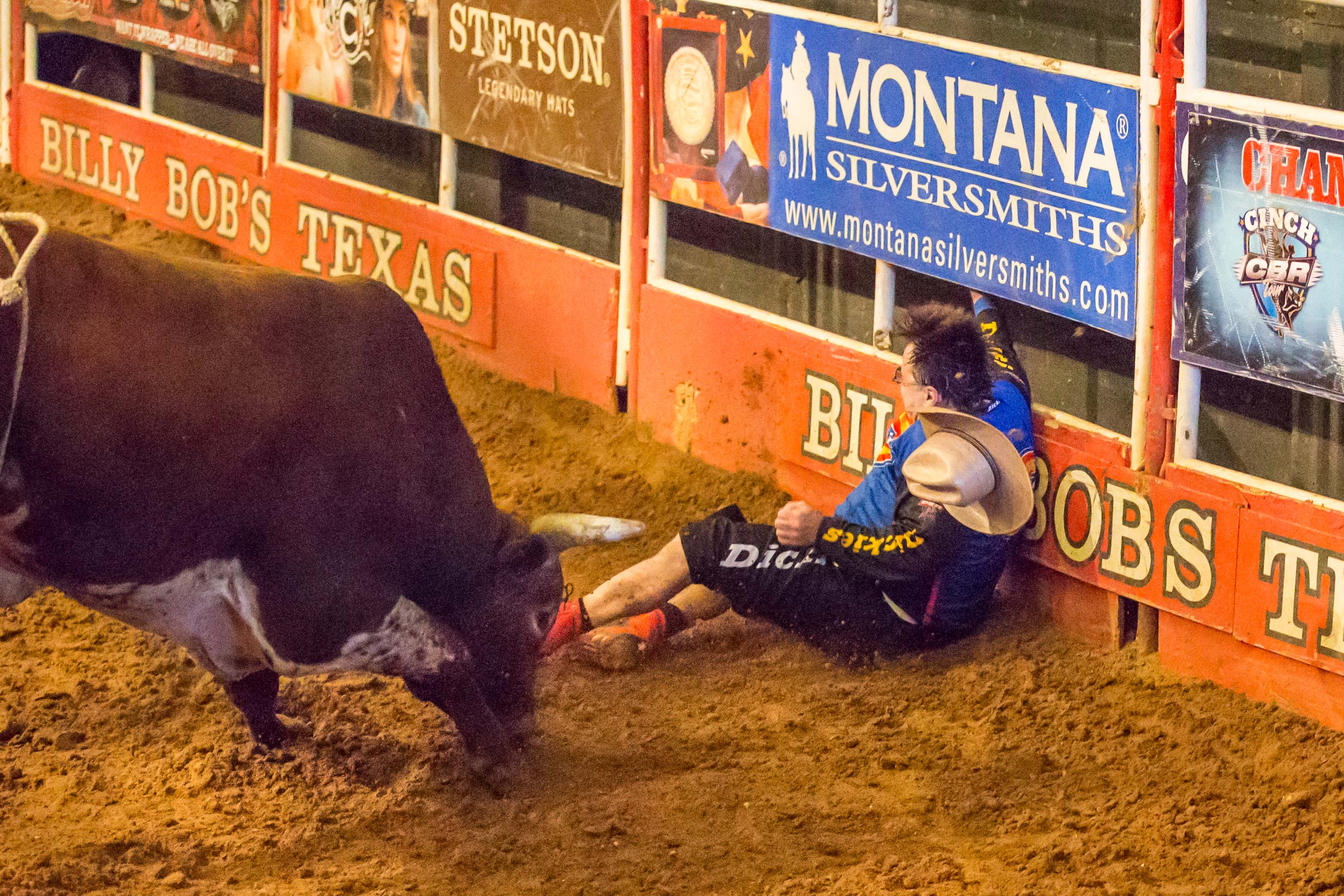Ernest Hemingway famously said: “Auto-racing, bull-fighting and
mountain-climbing are the only real sports…all others are games.”
The great writer’s point was that when genuine risk is involved in
competition, an experience becomes more meaningful.
By chance, Hemingway is my favorite author – plus I have tried two
“real” sports by his definition. In 1998 I summited the Matterhorn
and in 2002 I drove a lap in excess of 200 mph in an Indy race car.
But bull-fighting was part of the Hemingway equation that long had eluded me.
So when Professional Bull Riders, Inc. (PBR) offered a chance to get into the ring with angry
bulls weighing close to a ton, I didn’t hesitate. With 20/20 hindsight, maybe I should have.

8 seconds. Fewer than half the riders are able to do so. (Photo
courtesy of PBR)
My venue would not be outdoors in the summer heat of Spain where
Hemingway wrote “Death in the Afternoon.” It would be indoors in the
winter at a place called Billy Bob’s Texas in Ft. Worth. And I would not be bull-fighting in the traditional
sense, with tights and a cape. Rather I’d be distracting bulls from
attacking helpless riders once they were thrown off.
Sean Gleason, PBR’s president and chief operating officer, says
bull-riding is the “fastest-growing sport on dirt.” Founded in 1992 by
20 riders who chipped in $1,000 each, the Pueblo, Colorado, outfit
quickly took off; by 1995, it had 310,000 fans attending live events.
In 2007 Spire Capital Partners took notice and acquired PBR. Each
original investor reaped over $4 million for his 1992 contribution.
Today PBR’s 1,200 riders compete in 300-plus events annually.
Attendance has jumped to 2.5 million fans, and coverage includes the
CBS Television Network and its affiliate the CBS Sports Network.
The most elite PBR tier is the Built Ford Tough Series. A season
includes 30 major shows in places like New York and Chicago, areas one
might not expect to find bull-riding fans, as well as more grass-roots
venues like Oklahoma City and Billings, Montana.
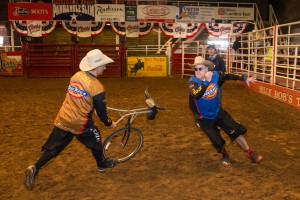
how to handle a charging bull using a mockup wheel. (Photo: Andy
Gregory/Humps n Horns Magazine)
For those who have never been to a PBR event, the goal of the rider is
to stay on a snorting, kicking bull for at least eight seconds with
one hand strapped to the beast’s backside. When the rider is thrown –
or if his free hand touches the bull – the clock stops and the scoring
tallied.
The bigger goal of riders is to place well enough on the annual
circuit to qualify for World Finals in Las Vegas. The profession can
be lucrative: J.B. Mauney, PBR’s recent 27-year-old World Champion,
earned $1.8 million in combined prize money last year.
Before getting into the ring myself, I attended two PBR shows as a
spectator – one at New York’s Madison Square Garden sitting in the
audience, the other in Chicago observing mid-ring in a green metal
cage where the TV camera crews work.
Both performances opened with loud, flashy fireworks and a dramatic
introduction of the riders. Then bull after raging bull was released,
with well over half the riders being bucked off in under eight
seconds. The violence was astounding. Some bulls went back to the
chute quickly, almost relieved their “performance” was over, while
others hung around brazenly trying to attack the fallen riders.
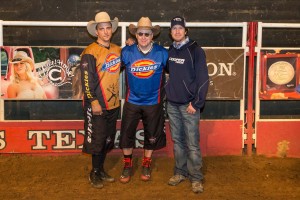
writer Jim Clash in Texas. (Photo: Andy Gregory/Humps n Horns
Magazine)
That’s where the bull-fighters come in. Shorty Gorham, 35, is one of
three who protect these riders during competition. Frank Newsom, Jesse
Byrne and Lyndel Runyan (alternate) are the others.
Think of these guys like a pit crew is to NASCAR racers, for support.
“We’ve got to get the bulls to chase us instead of the riders,” laughs
Gorham. “Mind control is toughest – reading the play, working as a
team. Panic and you’ll get run over.”
)
This is a video of Gorham being kicked in the face by the bull Hustle Up. He shrugs it
off. “It’s dangerous. Broken bones and hospital rooms are part of the
job. When you get into an arena with a bull, it’s going to happen –
and if you think otherwise you’re just plain crazy.”
While fatalities are rare – in 2000 PBR did experience one, rider Glen
Keeley – injuries are common. In his eight years with PBR, Gorham has
been to the hospital with broken ribs, crushed vertebrae and a busted
shoulder. “I probably should have gone more,” he grins.
For my bull-fighting experience, Gorham and Newsom were to be my
coaches. I would not wear a helmet, as most fighter injuries are
between the knees and shoulders, but I would have chest and hip pads
for protection.
)
The late NFL player Junior Seau and Sports Illustrated scribe Rick
Reilly both tried this stunt. Reilly stayed close to the fence when
the bulls were released while Seau got so close to action that he was
run over. I set my sights somewhere between the two for my own level of involvement.
On a sunny morning in late February, I met up with Gorham and Newsom
at Billy Bob’s, a Fort Worth institution known for its top-tier
country music and bull-riding. While dressing, I quickly realized that
the pads are more substantial than how they look from the audience.
They make you feel secure, but also limit mobility.
Gorham explained about the different types of bulls. Young ones tend
to be mean but dumb; older veterans of the circuit are wizened but
more docile. The most dangerous are older bulls who are still mean.
“Like a pitcher’s job is to know the batter, we’ve got to know the
bulls,” Gorham says, “and you tend to remember the really bad ones the
most.” Of the bulls J. W. Hart brought to Billy Bob’s that day, I was
assured none were “really bad.”
After stretching and signing liability waivers, we practiced in the
dirt arena with a one-wheeled contraption which had a small bull’s
head attached. Gorham and Newsom simulated attacking me with it. The
trick was to take an angle toward the charging bull, but not head on,
and then pivot immediately after you had cleared his head and horns.
The idea is you render him powerless, and can run him in tight circles
until he tires or another fighter distracts him.

Man without incident. (Photo: Andy Gregory/Humps n Horns Magazine)
It sounds easy, but trust me it is not. “Today you’re like a preschool
kid learning to write the letter ‘A’,” said Newsom, 39. “Hopefully
you’ll retain some muscle memory when the real bulls come out.” After
an hour of these drills, I was deemed “ready.”
The first bull released was six-year-old Repo Man, who had a decent
disposition as older bulls go. After he threw his rider, he lingered
in the ring while Gorham and Newsom challenged him. They chided me to
join in, which I did – tentatively. I was scared to death, but tried
to remember what they had just taught me. I had a few close
encounters, one where Repo Man’s horn grazed my back, but we
eventually got him into the chute. No harm, no foul.
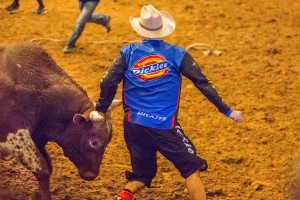
thrown. (Photo: Andy Gregory/Humps n Horns Magazine)
The next bull, Horny Toad, was definitely more active. The
four-year-old gave his rider a really good buck and, after he threw
him, was looking for more. First, he went after Newsom. But then,
center ring, the raging beast zoned in on me. We locked eyes and I
took my angle, running to his right as he attacked me. By now some of
the fear had waned and my adrenaline took over. Hard as I tried, I
came up just a little short and didn’t get all the way around the
bull’s huge head. His horns were suddenly between the fence and me.
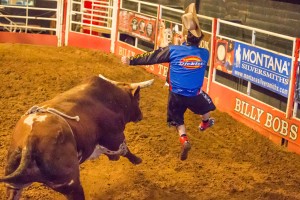
Toad. At this point, Clash is just along for the ride. (Photo: Andy
Gregory/Humps n Horns Magazine)
I tried to get him to circle anyway but knew I was in trouble. Just
like that, he flicked me with his right horn as if I was a pesky
mosquito, launching me into the air. I hit the metal fence hard and
bounced. Just as he readied to pummel me again while I lay crumpled on
the dirt, Gorham and Newsom distracted him away, just like they do in
their real jobs.
Stunned, I stayed down for maybe a second too long. Gorham yelled (and
I mean yelled), “Get the ‘expletive’ up.” I grabbed my hat and climbed
out of the ring, tail between my legs. They then corralled the beast
back into the chute.
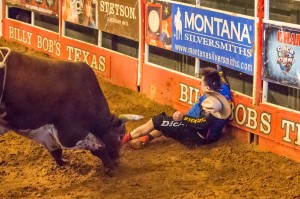
the Texas ring. PBR bull-fighters Frank Newsom and Shorty Gorham
quickly distracted the bull before it had a chance for a second
attack. (Photo: Andy Gregory/Humps n Horns Magazine)
To say I felt battered is an understatement. My right arm was torn up
with cuts and scrapes, and my left-side ribs felt like a Mack truck
had hit me. My tailbone was severely bruised, too. The EMTs gave me
the once-over, clearing me, but I sure was sore. I probably cracked a
few ribs.
Newsom saddled up with a smile and said, “You ready to go again?” I
think he was half-serious – they don’t call him “Fearless Frank” for
nothing. I just grinned and shook my head. He laughed, then he and
Gorham went back into the ring with another J.W. bull. This time I
watched safely from the stands – and with tremendous respect. They
make the dance look so easy.
For all the risks, pay for PBR bull-fighters is modest compared to the
top riders. Gorham says he makes less than $150,000 annually, out of
which he covers travel and lodging on tour – and medical deductibles.
As a group, though, the riders are appreciative of the fighters’
efforts. They collectively vote them in every year — and that’s good
enough for Gorham. “It means they’re confident in our abilities,” he
says. “When your life’s on the line, politics don’t mean a damn thing.
You can’t be a sissy and do this job.”
Perhaps the champ rider Mauney sums it up best. “I tried fighting
bulls when I was younger. I liked it but stuck with riding,” he says.
“I feel a lot safer on their backs than standing in front of them.”

Magazine)
Jim Clash is an Explorers Club [www.explorers.org] Fellow and
Director, is author of “The Right Stuff: Interviews With Icons of the
1960s” and “The Right Stuff: Interviews With Icons of the 1970s and
1980s” (AskMen, 2012), and “Forbes To The Limits” (Wiley, 2003).
